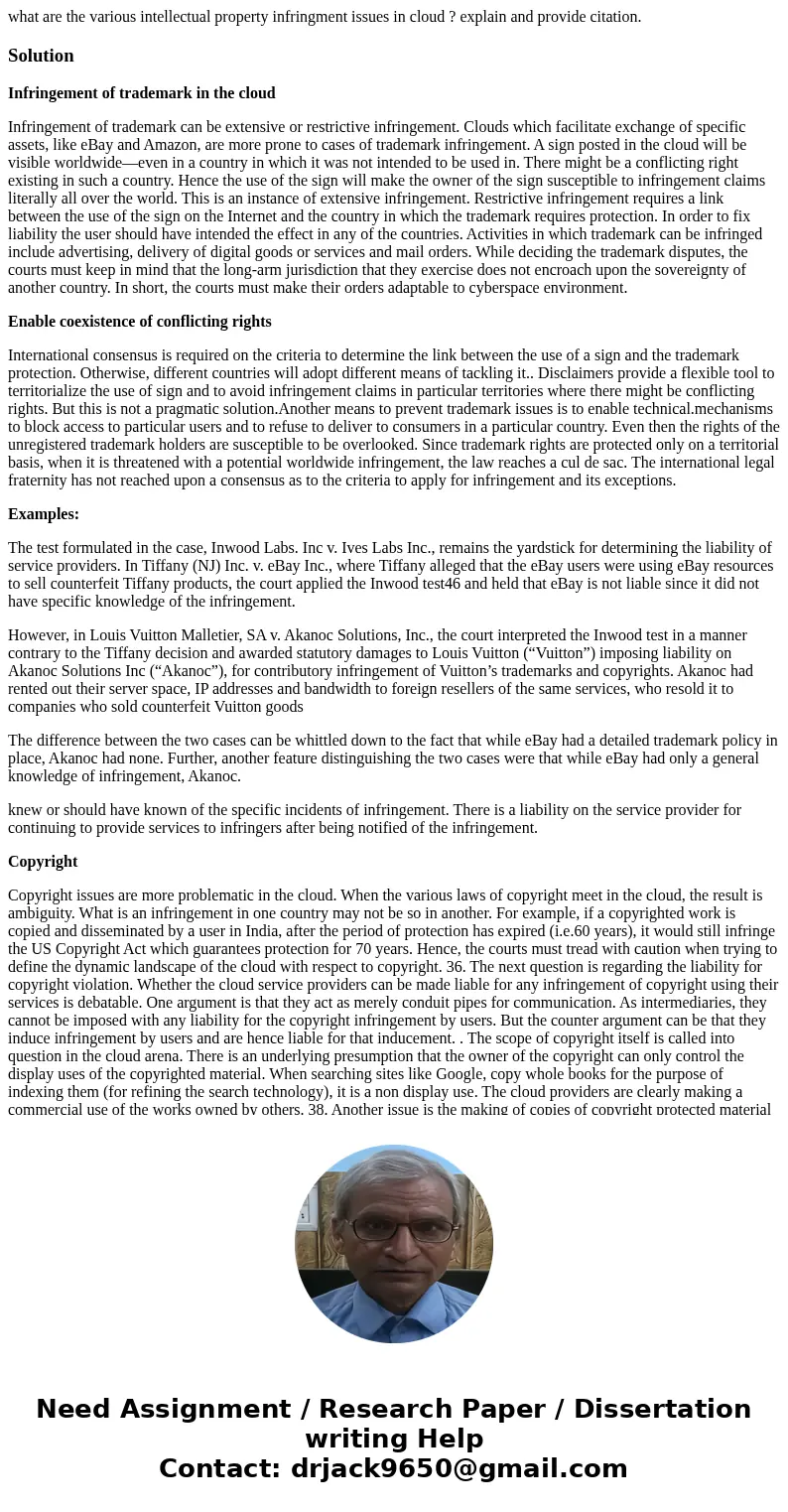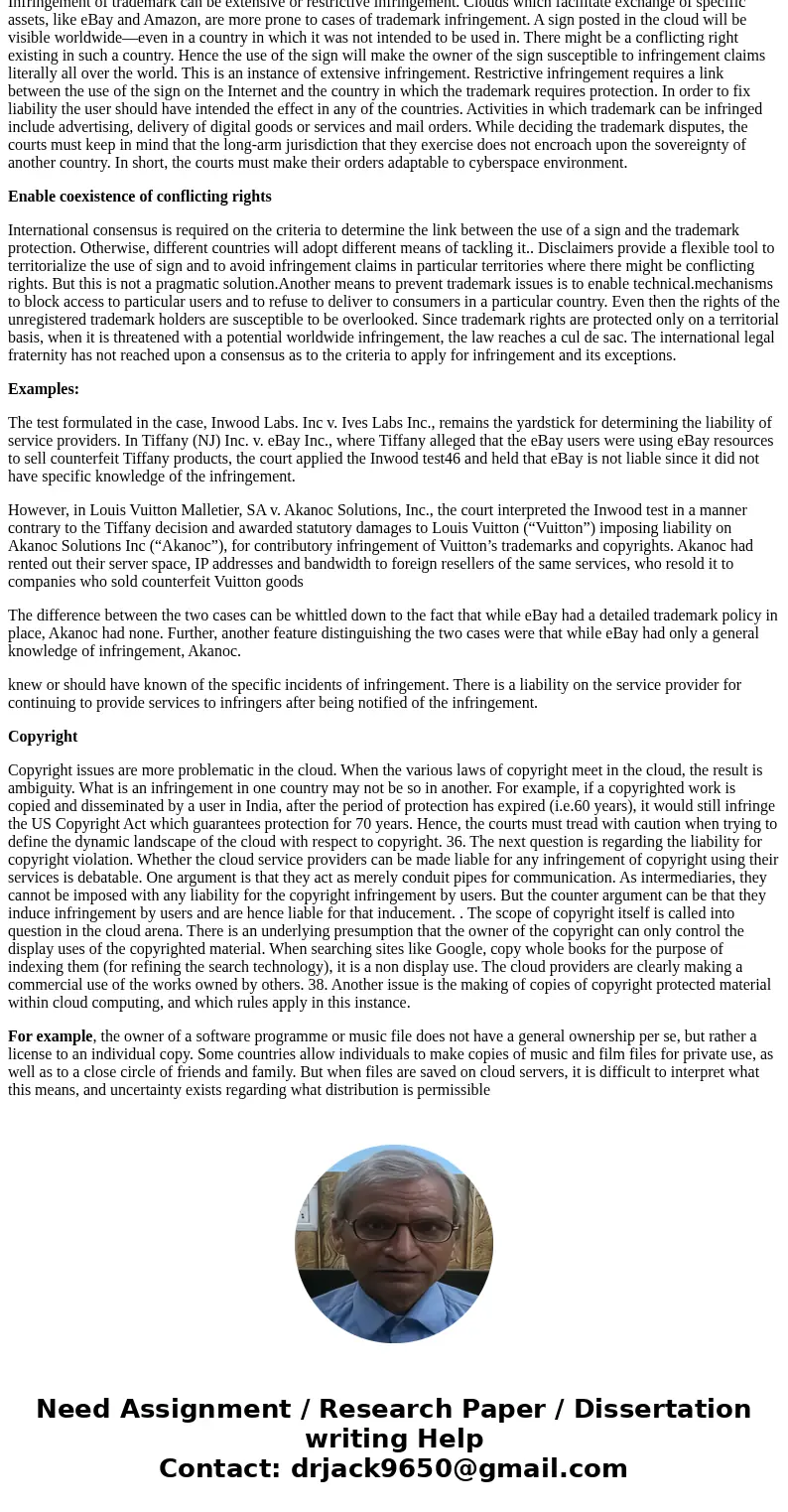what are the various intellectual property infringment issue
what are the various intellectual property infringment issues in cloud ? explain and provide citation.
Solution
Infringement of trademark in the cloud
Infringement of trademark can be extensive or restrictive infringement. Clouds which facilitate exchange of specific assets, like eBay and Amazon, are more prone to cases of trademark infringement. A sign posted in the cloud will be visible worldwide—even in a country in which it was not intended to be used in. There might be a conflicting right existing in such a country. Hence the use of the sign will make the owner of the sign susceptible to infringement claims literally all over the world. This is an instance of extensive infringement. Restrictive infringement requires a link between the use of the sign on the Internet and the country in which the trademark requires protection. In order to fix liability the user should have intended the effect in any of the countries. Activities in which trademark can be infringed include advertising, delivery of digital goods or services and mail orders. While deciding the trademark disputes, the courts must keep in mind that the long-arm jurisdiction that they exercise does not encroach upon the sovereignty of another country. In short, the courts must make their orders adaptable to cyberspace environment.
Enable coexistence of conflicting rights
International consensus is required on the criteria to determine the link between the use of a sign and the trademark protection. Otherwise, different countries will adopt different means of tackling it.. Disclaimers provide a flexible tool to territorialize the use of sign and to avoid infringement claims in particular territories where there might be conflicting rights. But this is not a pragmatic solution.Another means to prevent trademark issues is to enable technical.mechanisms to block access to particular users and to refuse to deliver to consumers in a particular country. Even then the rights of the unregistered trademark holders are susceptible to be overlooked. Since trademark rights are protected only on a territorial basis, when it is threatened with a potential worldwide infringement, the law reaches a cul de sac. The international legal fraternity has not reached upon a consensus as to the criteria to apply for infringement and its exceptions.
Examples:
The test formulated in the case, Inwood Labs. Inc v. Ives Labs Inc., remains the yardstick for determining the liability of service providers. In Tiffany (NJ) Inc. v. eBay Inc., where Tiffany alleged that the eBay users were using eBay resources to sell counterfeit Tiffany products, the court applied the Inwood test46 and held that eBay is not liable since it did not have specific knowledge of the infringement.
However, in Louis Vuitton Malletier, SA v. Akanoc Solutions, Inc., the court interpreted the Inwood test in a manner contrary to the Tiffany decision and awarded statutory damages to Louis Vuitton (“Vuitton”) imposing liability on Akanoc Solutions Inc (“Akanoc”), for contributory infringement of Vuitton’s trademarks and copyrights. Akanoc had rented out their server space, IP addresses and bandwidth to foreign resellers of the same services, who resold it to companies who sold counterfeit Vuitton goods
The difference between the two cases can be whittled down to the fact that while eBay had a detailed trademark policy in place, Akanoc had none. Further, another feature distinguishing the two cases were that while eBay had only a general knowledge of infringement, Akanoc.
knew or should have known of the specific incidents of infringement. There is a liability on the service provider for continuing to provide services to infringers after being notified of the infringement.
Copyright
Copyright issues are more problematic in the cloud. When the various laws of copyright meet in the cloud, the result is ambiguity. What is an infringement in one country may not be so in another. For example, if a copyrighted work is copied and disseminated by a user in India, after the period of protection has expired (i.e.60 years), it would still infringe the US Copyright Act which guarantees protection for 70 years. Hence, the courts must tread with caution when trying to define the dynamic landscape of the cloud with respect to copyright. 36. The next question is regarding the liability for copyright violation. Whether the cloud service providers can be made liable for any infringement of copyright using their services is debatable. One argument is that they act as merely conduit pipes for communication. As intermediaries, they cannot be imposed with any liability for the copyright infringement by users. But the counter argument can be that they induce infringement by users and are hence liable for that inducement. . The scope of copyright itself is called into question in the cloud arena. There is an underlying presumption that the owner of the copyright can only control the display uses of the copyrighted material. When searching sites like Google, copy whole books for the purpose of indexing them (for refining the search technology), it is a non display use. The cloud providers are clearly making a commercial use of the works owned by others. 38. Another issue is the making of copies of copyright protected material within cloud computing, and which rules apply in this instance.
For example, the owner of a software programme or music file does not have a general ownership per se, but rather a license to an individual copy. Some countries allow individuals to make copies of music and film files for private use, as well as to a close circle of friends and family. But when files are saved on cloud servers, it is difficult to interpret what this means, and uncertainty exists regarding what distribution is permissible


 Homework Sourse
Homework Sourse